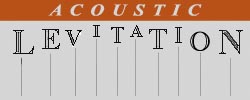 |
|
ARTS |
CULTURE |
|
Mission Newsletter |
|
Arditti String
Quartet. Horatiu Radulescu's Fourth Quartet illuminates a new spectral sound world by juxtaposing a 128-pitch, "viola da gamba" scordatura (using a'= 433 hertz) with 29 orbiting spectra based around a'= 431. Fifteen years have elapsed between the Quartet's premiere and the availability of this beautiful work's first recording. Ironically, despite our instant communications, recording, and reproduction technologies, some things happen more slowly now than in the past. This timing fits in with Radulescu's ethos, his view of music as a means in a "quest of the eternal." Things happen in their own time, at a correct moment. The Fourth had a long germination period; the composer assigns 1976-1987 as the date of its composition, and the 1987 London premiere took place three years after the Festival de La Rochelle, for which it was commissioned. Completed the year before Giacinto Scelsi died, Radulescu's Fourth Quartet extends the reaches created by the elder composer in his magnum opus, also a Fourth Quartet (1964). When Scelsi passed away, Radulescu immediately composed a beautiful piece in his memory. Long before then, however, Radulescu had engaged in Scelsi's language, and the present Fourth quotes (from 27:40 to 28:00) one of the most salient moments in Scelsi's Fourth, where suddenly, out of the undifferentiated mass of pulsating sound, emerge two lines moving in opposite directions. Harmut Möller's and Radulescu's own notes together provide a great deal of information to guide listeners, including four illustrations concerning the score. One of the figures gives the scordatura of the 128 strings, each tuned to a different frequency, of an imaginary viola da gamba (played by eight string quartets). Radulescu uses increments of 2, 3, 4, 5, 8, and 16 cycles per second to tune the strings across a range of 36 and 641 cps, with half of the strings (64) tuned in increments of 2 cps, between the range of 131 and 257 cps. The eight quartets playing this tuning can be either live or prerecorded, and symbolize the earth. The central, ninth quartet uses normal tuning, but based on a'= 431 hertz. That quartet uses 27 different spectra to create "solar systems" that move about, orbiting the "'terrestrial' dense sound-life" (Radulescu). Their movement represents a quest for the eternal. Like Scelsi's Fourth, this Quartet concerns ontology. Radulescu subtitled the work "infinite to be cannot be infinite, infinite anti-be could be infinite," in "answer to Shakespeare's 'to be or not to be' and to Lao-Tzu's 'being and non-being create each other'." As Scelsi and many others have done, Radulescu uses ascent as the musical representation (or sonic means) of the spiritual quest. This piece ascends, descends, starts again from a high point in order to descend, and concludes with a final ascent. Radulescu correlates ascending pitch with lessening duration, and vice versa. The 89 orbits of the central quartet last from 4 to 64 seconds, moving from longer to shorter in the two ascending segments, and lengthening in the two descending segments (these durations appear, barely legible, in Figure 2 of the CD notes). The live quartet's 89 orbits overlap the 137 "sound-mobiles" of the pre-recorded quartets. Radulescu always modifies his process-structures to avoid strict linearity, though the modifications appear to be relatively small. He uses dilation/contraction of spectra, ring modulation, and enigmatic "thunder/lightning" multi-part trajectories to enliven the sound fabric. Horatiu Radulescu subtitled this 49-minute work "hommage à Leonardo da Vinci," and it is both a fitting tribute to that great musical scientist and a leap forward on the road established by another inventive Italian, Giacinto Scelsi. Unlike Scelsi, many of whose paramount works waited decades for their premieres, Radulescu has gained sufficient acknowledgment in the new music world to ensure timely performances of his new works. Beyond the limited capacity of the concert hall, however, access to Radulescu's music lies in the hands of record company executives. I applaud Edition RZ's efforts in making this great music available to a wider audience. Compact disc with 16-page booklet in German, English, and French. (Reprinted from
our former incarnation as Jump Arts Journal.) |
(c)2008 - 2016 All contents copyrighted by AcousticLevitation.org. All contributors maintain individual copyrights for their works.